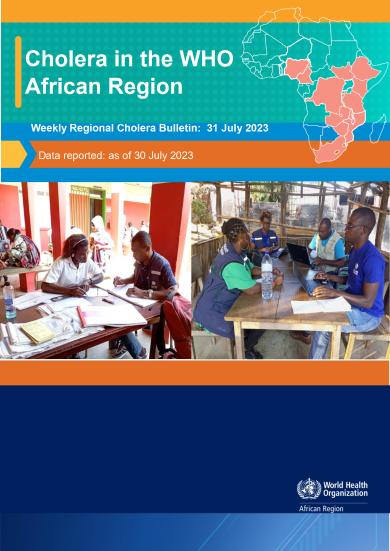
Cholera in the WHO African Region: Weekly Regional Cholera Bulletin: 31 July 2023
The cholera outbreak has affected 15 countries in the WHO African Region with Uganda recently reporting a new outbreak in two districts. With the rainy season commencement in the West African region there is risk of more cholera outbreaks on the horizon. The trend across the region is currently closely monitored and this highlights the need for Member States to enhance readiness, heighten surveillance and institute preventive and control measures in communities and around border crossings to prevent and mitigate cross border infection.
In Epidemiological week 30 (ending 30 July), ten countries Burundi, Cameroon, Ethiopia, Kenya, Malawi, Mozambique, South Africa, Uganda, United Republic of Tanzania and Zimbabwe reported a total of 847 new cases. Transmission is currently active in 12 countries with no recent report of new cases from Eswatini (last reported April 18), South Sudan (last reported May 16) and Zambia (last reported June 15).
Since 1 January 2022, a cumulative total of 222 994 cholera cases has been reported to the WHO Regional Office for Africa (AFRO), including 4 091 deaths with a case fatality ratio (CFR) of 1.8% as of 30 July 2023 (Table 1). Cameroon, Democratic Republic of the Congo, Malawi, Mozambique, and Nigeria account for 83.4% (185 951) of the cumulative cases and 85.6% (3 503) of all cumulative deaths reported.
The cholera outbreaks in the African Region are occurring in the context of natural disasters such as flooding (Mozambique, Malawi), drought (Kenya and Ethiopia), conflict (Cameroon, Democratic Republic of the Congo, Nigeria, Ethiopia) and multiple disease outbreaks including Mpox, wild polio, measles, COVID-19, etc. Many countries have limited and strained resources, shortage of medical commodities, including cholera kits and Oral Cholera Vaccine (OCV). Poor sanitation and unreliable water supplies with increased cross-border movements also serve as driving factors for the outbreak across the region.